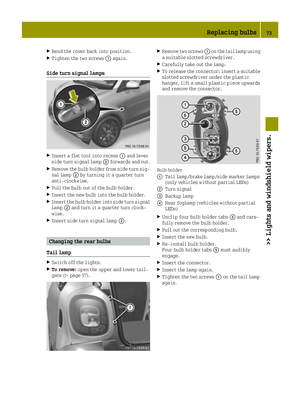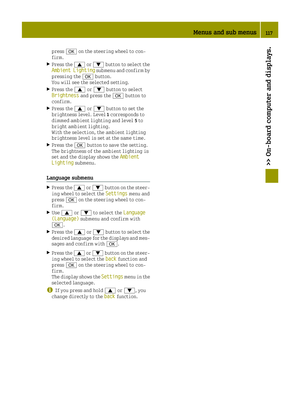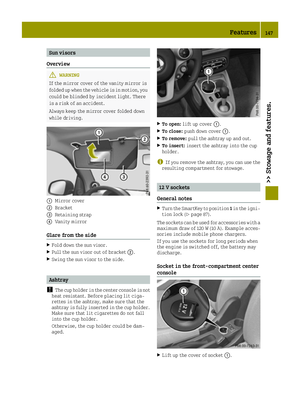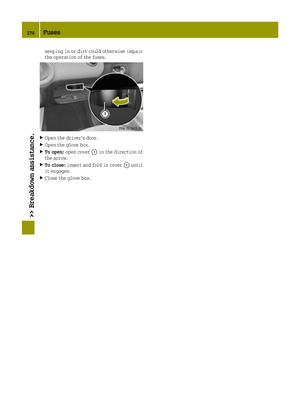Page 17 of 214

Vehicle dimensions....................... 212
Vehicle emergency locking .............. 55
Vehicle identification number
see VIN
Vehicle identification plate .......... 205
Vehicle key
see SmartKey
Vehicle tool kit ............................ 161
Ventilation
see Climate control
VIN ............................................ 205
W
Warning and indicator lamps
ABS ....................................... 134
Airbag ................................... 132
Battery ................................... 137
Brakes ................................... 132
Check Engine ........................... 136
Coolant .................................. 138
Distance warning function (red) .. 136
Distance warning function (yel-
low) ....................................... 135
Door ...................................... 141
EBD ....................................... 133
Electronics .............................1 41
ESP
®...................................... 134
Oil pressure ............................ 138
Overview ................................. 24
Parking brake .......................... 132
PASSENGER AIR BAG .................... 30
Restraint system ......................1 32
Seat belt ................................. 131
Steering ................................. 141
Tire pressure monitor ............... 139
Warranty ....................................... 17
Wheel and tire combination
see Tires
Wheel bolt tightening torque .......... 200
Wheels
Changing a wheel ..................... 196
Checking ................................ 178
Cleaning ................................ 157
General notes .......................... 200
Important safety notes ............... 177
Interchanging/changing ............ 196
Mounting a new wheel ................ 199 Mounting a wheel ...................... 197
Removing a wheel ..................... 199
Snow chains ............................. 179
Storing .................................. 197
Tightening torque .................... 200
Wheel size/tire size ................. 200
Window curtain air bag
Operation ................................ 36
Windows
see Side windows
Windscreen
see Windshield
Windshield
Defrosting ............................... 82
Windshield washer fluid
see Windshield washer system
Windshield washer system
Adding washer fluid .................. 153
Important safety notes ............... 211
Windshield wipers
Intermittent wiping ................... 75
Problem (malfunction) ................ 78
Rear window wiper ..................... 75
Replacing the wiper blades ......... 75
Switching on/off ....................... 74
Winter driving
Slippery road surfaces .............. 105
Snow chains ............................. 179
Winter operation
General notes .......................... 179
Winter tires
M+S tires ................................ 179
Wiper blades
Cleaning ................................ 157
Important safety notes ................ 75
Replacing (rear window) ............. 76
Replacing (windshield) ............... 76
Workshop
see Qualified specialist workshop
Index15
Page 18 of 214

Protection of the environment
General notes
HEnvironmental note
Daimler's declared policy is one of com-
prehensive environmental protection.
The objectives are for the natural resour-
ces that form the basis of our existence on
this planet to be used sparingly and in a
manner that takes the requirements of both
nature and humanity into account.
You too can help to protect the environment
by operating your vehicle in an environ-
mentally responsible manner.
Fuel consumption and the rate of engine,
transmission, brake and tire wear are
affected by these factors:
Roperating conditions of your vehicle
Ryour personal driving style
You can influence both factors. You should
bear the following in mind:
Operating conditions:
Ravoid short trips as these increase fuel
consumption.
Ralways make sure that the tire pressures
are correct.
Rdo not carry any unnecessary weight.
Ra regularly serviced vehicle will con-
tribute to environmental protection. You
should therefore adhere to the service
intervals.
RAlways have service work carried out at a
qualified specialist workshop.
Personal driving style:
Rdo not depress the accelerator pedal
when starting the engine.
Rdo not warm up the engine when the vehi-
cle is stationary.
Rdrive carefully and maintain a safe dis- tance from the vehicle in front.
Ravoid frequent, sudden acceleration and
braking.
Rchange gear in good time and use each
gear only up to 00C3of its maximum engine
speed.
Rswitch off the engine in stationary traf-
fic.
Rkeep an eye on the vehicle's fuel con-
sumption.
Environmental concerns and recom-
mendations
Wherever the operating instructions require you to dispose of materials, first try to
regenerate or re-use them. Observe the rel-
evant environmental rules and regulations
when disposing of materials. In this way you
will help to protect the environment.
Genuine smart parts
HEnvironmental note
Daimler AG also supplies reconditioned
major assemblies and parts which are of the
same quality as new parts. They are covered
by the same Limited Warranty entitlements
as new parts.
!Air bags and Emergency Tensioning Devi-
ces, as well as control units and sensors for
these restraint systems, may be installed
in the following areas of your vehicle:
Rdoors
Rdoor pillars
Rdoor sills
Rseats
Rcockpit
Rinstrument cluster
Rcenter console
Do not install accessories such as audio
systems in these areas. Do not carry out
repairs or welding. You could impair the
operating efficiency of the restraint sys-
tems.
Have aftermarket accessories installed at
a qualified specialist workshop.
You could jeopardize the operating safety of
your vehicle if you use parts, tires and wheels
16>> Introduction.
Page 19 of 214

as well as accessories relevant to safety
which have not been approved by smart. This
could lead to malfunctions in safety-relevant
systems, e.g. the brake system. Use only gen-
uine smart parts or parts of equal quality.
Only use tires, wheels and accessories that
have been specifically approved for your
vehicle.
Genuine smart parts are subject to strict
quality control. Each part has been specially
developed, manufactured or selected for
smart vehicles and fine-tuned for them.
Therefore, only genuine smart parts should be
used.
More than 300,000 different genuine smart
parts are available for smart models.
All smart centers maintain a supply of genu-
ine smart parts for necessary service and
repair work. In addition, strategically loca-
ted parts delivery centers provide quick and
reliable parts service.
Always specify the vehicle identification
number (VIN) (
Ypage 205) when ordering gen-
uine smart parts.
Operator's Manual
Vehicle equipment
This Operator's Manual describes all models
and all standard and optional equipment of
your vehicle available at the time of going to
print. Country-specific differences are pos-
sible. Bear in mind that your vehicle may not
feature all functions described here. This
also applies to safety-relevant systems and
functions. The equipment in your vehicle may
therefore differ from that shown in the
descriptions and illustrations.
The original purchase agreement lists all
systems installed in your vehicle.
Should you have any questions concerning
equipment and operation, please consult a
smart center.
The Operator's Manual and Maintenance Book- let are important documents and should be
kept in the vehicle.
Service and vehicle operation
Warranty
The smart USA Warranty booklet (USA only) or
the Warranty booklet (Canada only) contains
detailed information about the warranties
covering your smart, including:
Rsmart USA Limited Warranty (USA only
RNew Vehicle Limited Warranty (Canada
only)
REmission System Warranty
REmission Performance Warranty
Rwarranty against perforation through cor-
rosion
RCalifornia, Connecticut, Maine, Massachu-
setts, New York, Pennsylvania, Rhode Island
and Vermont Emission Control System War-
ranty
Rsmartmove Assistance (Canada only)
RState warranty enforcement laws (Lemon
Laws)
Maintenance
The Service and Warranty Booklet describes
all the necessary maintenance work which
should be done at regular intervals.
Always bring the Service and Warranty Infor-
mation Booklet with you when bringing the
vehicle to an authorized smart center. The
service advisor will record every service for
you in the Service and Warranty Booklet.
Roadside Assistance
The smartmove Assistance (Canada) and smart
1 service (USA) Program provides factory
trained technical help in the event of a
breakdown. Calls to the toll-free Roadside
Assistance number
1-800-762-7887 (in USA)
1-877-627-8004 (in Canada)
will be answered by smart Customer Assis-
tance Representatives 24 hours a day, 365 days
a year. In accordance with standard program
guidelines, Roadside Assistance provides
vehicle service up to a reasonable distance
from the next paved road. We will make every
effort to assist in a breakdown situation;
however, the accessibility of your vehicle
>> Introduction.17
Z
Page 20 of 214

will be determined by our authorized smart
center technical help or the tow service pro-
vider on a case-by-case basis. Additional
charges may be applicable for a breakdown
location determined not to be a reasonably
accessible roadside location as determined
by our authorized technician and tow service
provider.
For additional information refer to the smart
Roadside Assistance Program brochure (USA)
or the Warranty Booklet (Canada) in your vehi-
cle literature portfolio.
Change of address or change of owner-
ship
In the USA: If you change your address, be sure
to send in the “Information Change Card”
found in the Warranty Information Booklet.
In Canada: If you change your address, be sure
to send in the “Change of Address Notice”
found in the Warranty Booklet, or simply call
the Customer Service at 1-800-387-0100.
Maintaining your current address informa-
tion with smart will enable us to contact you
should important new information about the
vehicle, such as recalls, become available.
If you sell your smart, please leave all liter- ature with the vehicle to make it available to
the next operator.
In the USA: If you bought this vehicle used, be
sure to send in the “Information Change Card”
found in the Warranty Information Booklet.
In Canada: If you bought this vehicle used, be
sure to send in the “Notice of Pre‑Owned
Vehicle Purchase” found in the Warranty
Booklet, or call the Customer Service at
1-800-387-0100.
Operating your vehicle outside the USA
or Canada
When you are abroad with your vehicle,
observe the following points:
RService facilities or replacement parts
may not be readily available.
RUnleaded gasoline for vehicles with cata-
lytic converters may not be available; the use of leaded fuels will damage the cata-
lysts.
RGasoline may have a considerably lower
octane rating, and improper fuel can cause
engine damage.
Operating safety
Important safety notes
GWARNING
If you do not have the prescribed service/
maintenance work or any required repairs
carried out, this can result in malfunctions or system failures. There is a risk of an
accident.
Always have the prescribed service/main-
tenance work as well as any required
repairs carried out at a qualified special-
ist workshop.
GWARNING
Flammable material such as leaves, grass or
twigs may ignite if they come into contact
with hot parts of the exhaust system. There
is a risk of fire.
When driving off road or on unpaved roads,
check the vehicle's underside regularly. In
particular, remove parts of plants or other
flammable materials which have become
trapped. In the case of damage, contact a
qualified specialist workshop.
GWARNING
Modifications to electronic components,
their software as well as wiring can impair
their function and/or the function of other
networked components. In particular, sys-
tems relevant to safety could also be affec-
ted. As a result, these may no longer func-
tion as intended and/or jeopardize the
operating safety of the vehicle. There is an increased risk of an accident and injury.
Never tamper with the wiring as well as
electronic components or their software.
You should have all work to electrical and
18>> Introduction.
Page 21 of 214

electronic equipment carried out at a
qualified specialist workshop.
If you make any changes to the vehicle elec-
tronics, the general operating permit is ren-
dered invalid.
!There is a risk of damage to the vehicle if:
Rthe vehicle becomes stuck, e.g. on a high
curb or an unpaved road
Ryou drive too fast over an obstacle, e.g. a
curb or a hole in the road
Ra heavy object strikes the undercarriage
or parts of the chassis
In situations like this, the body, the under-
carriage, chassis parts, wheels or tires
could be damaged without the damage being
visible. Components damaged in this way
can unexpectedly fail or, in the case of an
accident, no longer withstand the strain
they are designed to.
If the underbody paneling is damaged,
combustible materials such as leaves,
grass or twigs can gather between the
underbody and the underbody paneling. If
these materials come in contact with hot
parts of the exhaust system, they can catch
fire.
In such situations, have the vehicle
checked and repaired immediately at a
qualified specialist workshop. If on con-
tinuing your journey you notice that driv-
ing safety is impaired, pull over and stop
the vehicle immediately, paying attention
to road and traffic conditions. In such
cases, consult a qualified specialist work-
shop.
Declarations of conformity
Vehicle components which receive
and/or transmit radio waves
USA: "The wireless devices of this vehicle
comply with Part 15 of the FCC Rules. Opera-
tion is subject to the following two condi-
tions: 1) These devices may not cause harmful interference, and 2) These devices must
accept any interference received, including
interference that may cause undesired oper-
ation. Changes or modifications not
expressly approved by the party responsible for compliance could void the user’s author-
ity to operate the equipment."
Canada:
"The wireless devices of this vehicle
comply with Industry Canada license-exempt
RSS standard(s). Operation is subject to the
following two conditions: (1) These devices
may not cause interference, and (2) These
devices must accept any interference,
including interference that may cause unde-
sired operation of the device."
Diagnostics connection
The diagnostics connection is only intended
for the connection of diagnostic equipment
at a qualified specialist workshop.
GWARNING
If you connect equipment to the diagnostics
connection in the vehicle, it may affect the
operation of the vehicle systems. As a
result, the operating safety of the vehicle
could be affected. There is a risk of an
accident.
Do not connect any equipment to a diagnos-
tics connection in the vehicle.
GWARNING
Objects in the driver's footwell can
restrict the pedal travel or obstruct a
depressed pedal. The operating and road
safety of the vehicle is jeopardized. There
is a risk of an accident.
Make sure that all objects in the vehicle are
stowed correctly, and that they cannot enter
the driver's footwell. Install the floormats securely and as specified in order to
ensure sufficient clearance for the pedals.
Do not use loose floormats and do not place
floormats on top of one another.
!If the engine is switched off and equip-
ment on the diagnostics connection is used,
the starter battery may discharge.
Connecting equipment to the diagnostics
connection can lead to emissions monitoring
information being reset, for example. This
may lead to the vehicle failing to meet the
>> Introduction.19
Z
Page 22 of 214

requirements of the next emissions test dur-
ing the main inspection.
Qualified specialist workshop
A smart center is a qualified specialist
workshop. It has the necessary specialist
knowledge, tools and qualifications to cor-
rectly carry out the work required on your
vehicle. This is especially the case for work
relevant to safety.
Observe the notes in the Maintenance Book-
let.
Always have the following work carried out at
a smart center:
Rwork relevant to safety
Rservice and maintenance work
Rrepair work
Ralterations, installation work and modifi-
cations
Rwork on electronic components
Correct use
If you remove any warning stickers, you or
others could fail to recognize certain dan-
gers. Leave warning stickers in position.
Observe the following information when
driving your vehicle:
Rthe safety notes in this manual
Rthe Technical Data section in this manual
Rtraffic rules and regulations
Rlaws and safety standards pertaining to
motor vehicles
Problems with your vehicle
If you should experience a problem with your
vehicle, particularly one that you believe
may affect its safe operation, we urge you to
immediately contact an authorized smart
center to have the problem diagnosed and
corrected if required. Do not drive the vehi-
cle if you believe it may not be safely oper-
ated. If the matter is not handled to your sat-
isfaction, please discuss the problem with
the smart center management, or if necessarycontact us at one of the following addresses:
In the USA Mercedes-Benz USA, LLC
One Mercedes Drive
Montvale, NJ 07645
In Canada
Customer Relations Department
98 Vanderhoof Avenue
Mercedes-Benz Canada, Inc.
Toronto, Ontario M4G 4C9
QR codes for rescue card
The QR codes are secured in the fuel filler
flap and on the opposite side on the B-pillar.
In the event of an accident, rescue services
can use the QR code to quickly find the appro-
priate rescue card for your vehicle. The cur-
rent rescue card contains the most important
information about your vehicle in a compact
form, e.g. the routing of the electric cables.
You can find more information under http://
portal.aftersales.i.daimler.com/public/
content/asportal/en/communication/
informationen_fuer/QRCode.html.
Data stored in the vehicle
Data recording
This vehicle is capable of recording diag-
nostic information relating to vehicle oper-
ation, malfunctions, and user settings. This
may include information about the perform-
ance or status of various systems, including
but not limited to, engine, throttle, steering
or brake systems, that is stored and can be
read out with suitable devices, particularly
when the vehicle is serviced. The data
obtained is used to properly diagnose and
service your vehicle or to further optimize
and develop vehicle functions.
Event data recorders
This vehicle is equipped with an event data
recorder (EDR). The main purpose of an EDR is
to record data that will assist in understand-
ing how a vehicle’s systems performed in cer-
tain crash or near crash-like situations, such
as during air bag deployment or when hitting
a road obstacle. The EDR is designed to record
20>> Introduction.
Page 23 of 214

data related to vehicle dynamics and safety
systems for a short period of time, typically
30 seconds or less.
The EDR in this vehicle is designed to record
such data as:
Rhow various systems in your vehicle are
operating
Rwhether or not the driver and passenger
seat belts are fastened
Rhow far (if at all) the driver is depressing
the accelerator and/or brake pedal and
Rhow fast the vehicle is traveling
This data can help provide a better under-
standing of the circumstances in which
crashes and injuries occur. NOTE: EDR data is
recorded by your vehicle only if a nontrivial
crash situation occurs. No data is recorded by
the EDR under normal driving conditions. No
personal data (e.g., name, gender, age, and
accident location) are recorded. However,
other parties, such as law enforcement, can
combine the EDR data with the type of per-
sonal identification data routinely acquired
during a crash investigation. EDR data may be
used in civil and criminal matters as a tool in
accident reconstruction, accident claims,
and vehicle safety.
To read data recorded by an EDR, special
equipment is required, and access to the
vehicle or the EDR is needed. In addition to
the vehicle manufacturer, other parties that
have the special equipment, such as law
enforcement, can read the information by
accessing the vehicle or the EDR.
EDR data may be used in civil and criminal
matters as a tool in accident reconstruction,
accident claims, and vehicle safety. Since
the Crash Data Retrieval CDR tool that is used
to extract data from the EDR is commercially
available, Mercedes-Benz USA, LLC
("MBUSA") expressly disclaims any and all
liability arising from the extraction of this
information by unauthorized Mercedes-Benz
personnel.
MBUSA will not share EDR data with others
without the consent of the vehicle owners or,
if the vehicle is leased, without the consent
of the lessee. Exceptions to this representa- tion include responses to subpoenas by law
enforcement; by federal, state or local gov-
ernment; in connection with or arising out of
litigation involving MBUSA or its subsidi a-
ries and affiliates; or, as required by law. Warning: the EDR is a component of the
Restraint System Module. Tampering with,
altering, modifying or removing the EDR com-
ponent may result in a malfunction of the
Restraint System Module and other systems.
State laws or regulations regarding EDRs that
conflict with federal regulation are pre-
empted. This means that in the event of such
conflict, the federal regulation governs. As
of February 2013, 13 states have enacted laws
related to EDRs.
Information on copyright
General information
You can find information on license for free
and open-source software used in your vehi-
cle and its electronic components on the fol-
lowing website:
http://www.mercedes-benz.com/opensource
>> Introduction.21
Z
Page 24 of 214
Dashboard
FunctionPage
0043Dashboard instruments110
0044Instrument cluster23
0087Horn
0085Windshield wipers combi-
nation switch74
0083Switches the automatic
locking feature on/off55
Switches the hazard warn-
ing lamps on/off69
0084Overhead control panel27
006Bsmart Audio-System/smart
Media-System (see the sep-
arate operating instruc-
tions)
FunctionPage
006CClimate control system
control panel79
006DIgnition lock87
006EAdjusts the steering wheel65
006FControl panel for:
Turning the forward colli-
sion warning on/off48
Turning the parking aid on/
off107
0070Lights combination switch67
0071Shift paddles96
22Dashboard
>> At a glance.
 1
1 2
2 3
3 4
4 5
5 6
6 7
7 8
8 9
9 10
10 11
11 12
12 13
13 14
14 15
15 16
16 17
17 18
18 19
19 20
20 21
21 22
22 23
23 24
24 25
25 26
26 27
27 28
28 29
29 30
30 31
31 32
32 33
33 34
34 35
35 36
36 37
37 38
38 39
39 40
40 41
41 42
42 43
43 44
44 45
45 46
46 47
47 48
48 49
49 50
50 51
51 52
52 53
53 54
54 55
55 56
56 57
57 58
58 59
59 60
60 61
61 62
62 63
63 64
64 65
65 66
66 67
67 68
68 69
69 70
70 71
71 72
72 73
73 74
74 75
75 76
76 77
77 78
78 79
79 80
80 81
81 82
82 83
83 84
84 85
85 86
86 87
87 88
88 89
89 90
90 91
91 92
92 93
93 94
94 95
95 96
96 97
97 98
98 99
99 100
100 101
101 102
102 103
103 104
104 105
105 106
106 107
107 108
108 109
109 110
110 111
111 112
112 113
113 114
114 115
115 116
116 117
117 118
118 119
119 120
120 121
121 122
122 123
123 124
124 125
125 126
126 127
127 128
128 129
129 130
130 131
131 132
132 133
133 134
134 135
135 136
136 137
137 138
138 139
139 140
140 141
141 142
142 143
143 144
144 145
145 146
146 147
147 148
148 149
149 150
150 151
151 152
152 153
153 154
154 155
155 156
156 157
157 158
158 159
159 160
160 161
161 162
162 163
163 164
164 165
165 166
166 167
167 168
168 169
169 170
170 171
171 172
172 173
173 174
174 175
175 176
176 177
177 178
178 179
179 180
180 181
181 182
182 183
183 184
184 185
185 186
186 187
187 188
188 189
189 190
190 191
191 192
192 193
193 194
194 195
195 196
196 197
197 198
198 199
199 200
200 201
201 202
202 203
203 204
204 205
205 206
206 207
207 208
208 209
209 210
210 211
211 212
212 213
213






